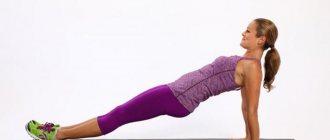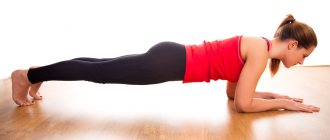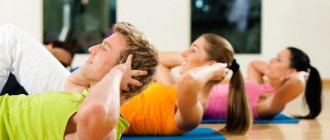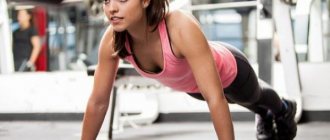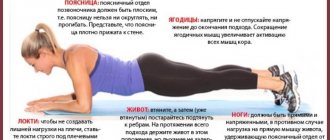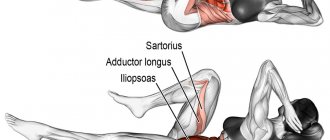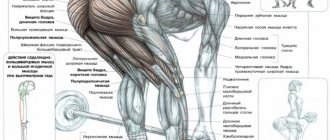The plank is one of the most effective and simplest ways to strengthen your abdominal muscles. When done correctly, it helps strengthen the muscles in your arms, back, and core. Below we will look at options for performing this exercise. Running and general physical training coach Alisa Matyash shows you how to perform the exercises correctly.
The “Health” section is your detailed guide to healthy lifestyle issues. Training, nutrition, amateur sports - we have only the most important and useful information that will help you become better every day. Subscribe to our telegram channel to be the first to receive the latest articles.
Types of planks and technique
Different types of exercises are similar in technique, but they train different muscle groups.
Straight arm plank
Standard version of the exercise. Place a mat on the floor and place your hands palms down. Raise your body so your back and legs should form a straight line. Hold this position for as long as possible, then rest and repeat the approach.
- Lie down on the floor as you would for regular push-ups. Raise your body, resting solely on your palms and toes. A perpendicular line should run from the shoulder along the arm to the floor.
- Your legs should not bend, try to keep them straight.
- The back does not arch or bend, the shoulder blades are slightly lowered. The tailbone should not protrude.
- The abdominal muscles should be in constant tension throughout the entire exercise.
- A small life hack - the further apart you spread your feet, the easier it will be for you to stand in the plank position, but the effectiveness of the exercise will decrease.
- Breathing during execution should be measured and calm.
Elbow plank
A more complex version of the plank, which involves keeping your body weight on your elbows and toes. Elbows are bent at an angle of 90 degrees. When performing the exercise, the body should be parallel to the floor, not sag or bend - it will be easier to keep a straight line if you tense your buttocks. In addition to the abdominal muscles, the muscles of the thigh and lower back, as well as the pectoral muscles, work here.
In this type of plank, basically everything is done in the same way as in the hand plank. The only difference will be that you rely not on your palms and hands, but on your forearms.
- Take your starting position.
- Bend your elbows, place them on the floor and rest on your forearms.
- To make the exercise more difficult, you can lift one leg or arm and keep it parallel to the floor.
- You can connect the plank on your elbows and arms, alternately changing positions - moving from a plank on your hands to a plank on your elbows and back, bending and extending your arms.
Plank with leg or arm extended
This exercise is more difficult because there are now three fulcrum points instead of four. Not only do you have to keep your body in a plank position, but you also have to make sure that the raised leg or arm does not fall below the line of your back. This plank provides a complex load on muscle groups and improves your sense of balance and balance.
Side plank
This version of the plank involves pumping the lateral abdominal muscles and oblique abdominal muscles - they are most involved in the exercise. Make sure that the body is in line with the legs, and the pelvis does not sag down. The feet need to be placed on top of each other, or the leg that is on top should be brought forward.
How to do a plank for beginners?
Do I need to do many variations at once and do all types of abdominal planks in one day? No. If you find forearm stand too difficult, try doing it with straight arms.
- Place your hands firmly on the ground, shoulder-width apart. Avoid elbow locks; they place unnecessary and often dangerous stress on the joint.
- Extend your legs, stabilizing yourself with the balls of your toes.
- Once in position, straighten your spine, tighten your abdominal muscles, squeeze your glutes and quads, and keep your head in a neutral position to form a straight line with your body.
- Again, don't let your hips sag or your butt rise toward the ceiling. Keep your body in a rigidly straight line throughout the entire workout.
If this is already boring for you, then you can diversify your training routine with variations of the plank. Try them all during the 30-day challenge.
- Place your forearms on an unstable surface, such as a Bosu ball.
- Place your feet on an unstable surface.
- Lift one leg off the floor while standing.
- Raise one hand off the floor.
- Bring your legs together and spread them as you jump.
- Alternately bring your right knee to your right armpit and your left knee to your left armpit.
- Swap your legs.
- Extend your right arm forward, then your left.
- Rotate your body from side to side, bringing your left knee to your right armpit and then your right knee to your left armpit.
- March your arms up and down.
- Lift your left arm and right leg at the same time, then switch to your right arm and left leg.
- Place your feet on a smooth surface and squeeze your core muscles to pull your legs towards you, becoming like a corner, and stretch them back.
- Rotate your upper body by raising your right arm into the air, return to the starting position and rotate to the other side by raising your left arm.
- Gently lower your knees to the floor one at a time during the plank.
- From a plank position on straight arms, begin “walking on your hands” forward.
- Again from a straight-arm plank position, begin to move your arms forward until your face almost touches the floor. Pause here to inhale, then return to the starting position.
One thing to remember is that the plank is a compound exercise that involves both your core and lower back. So don't worry if you feel some soreness in your lower back a few days after doing planks. This is actually a good thing because it means those muscles are working and will eventually get stronger with the plank.
What muscles are involved when doing a plank?
The plank is a universal exercise that uses many muscle groups during execution.
- Arm muscles - all types of exercise actively use the arms. During the exercise, you take a prone position, and your limbs are subject to heavy loads to keep your body in the desired position.
- Abdominal muscles - the essence of the exercise involves actively pumping the abdominal muscles, and various types of planks also pump the lateral abdominal muscles, which are difficult to quickly strengthen in any other way.
- Back muscles - during the exercise, your back should be straight, this is achieved through the work of the muscles and spine.
- Muscles of the legs and thighs - the body in the pelvic area is supported by weight thanks to the work of these muscles.
- Neck muscles - the head should be in line with the body, it should not be tilted down too much. The neck muscles, together with the upper trapezius, work to hold the head in the desired position.
Elbow plank technique
The forearm plank is a little easier to perform, so beginners should start with this option. It is also suitable for those who have injuries and diseases of the wrist joints.
- Take a position on all fours, lower your forearms to the floor parallel to each other. The elbows should be clearly under the shoulder joints.
- Straighten your legs and take them back, placing them on your toes the width of your pelvis.
- From head to toe, the body should be kept in a straight line.
- It is important to pull the abdominal muscles towards the spine, making the lower back flat, removing the sag, and twisting the pelvis.
- Breathe freely without holding your breath.
How long to stand in plank
Numerous marathons offer to learn how to stand in a plank for 5 or even 10 minutes in a row in a month. This is not very useful: in an untrained person, the target muscles quickly get tired. The opposite effect is obtained: the load is transferred to the ligaments and stabilizer muscles, the body is held in the desired position due to them, and not due to the muscles that you originally intended to pump.
Therefore, it is better for beginners to stand in the plank in short sets with little rest. For example, if you are doing a plank as part of a warm-up, you should stand for 10-30 seconds, followed by 10 seconds of rest, and perform 2-3 repetitions.
If the plank is part of the workout, and you perform it both statically and dynamically, in different positions, stand in each position for 60 seconds. Under the supervision of a trainer and if you are confident in your abilities, you can increase the duration to 1.5-2 minutes.
If you have back problems, it is better to perform the plank in short sets of 20 seconds with a rest on your knees for 3-5 seconds. You need to perform 5-8 repetitions (depending on your level of training). Doctors also advise performing side planks, alternately on each side, to strengthen the spinal muscles.
What muscles work in the plank?
Depending on the type of plank, some muscles work harder, while others, at a certain point, work less.
- Rectus abdominis muscle.
- Transverse abdominis muscle.
- Oblique abdominal muscles.
- Serratus anterior muscles.
- Pectoralis major muscle.
- Back extensor.
- Latissimus dorsi muscles.
- Quadriceps femoris.
- Thigh biceps.
- Deltoid muscles.
- Trapezius muscle.
- Calf muscles.
- Large gluteal muscles.
- Biceps.
- Triceps.
The effect of the plank on the abs
By engaging the transverse abdominis muscle, which is deep and located beneath the rectus abdominis muscle, which stabilizes the lumbar spine, the abdominal muscles are uniformly strengthened. The transverse abdominis muscle is involved in maintaining the lumbar lordosis, which is often in hyperflexion, due to the lack of tone of the transverse muscle. Also, thanks to this, the stomach becomes flat, as if it is approaching the walls of the spine.
The benefits and harms of planks
The plank is useful not only for complex pumping of the muscles of the back, abs and legs, but also for increasing concentration, developing the ability to maintain balance and balance, etc. Let's look at the main benefits of the exercise, and also talk about contraindications.
Benefits for the back
The back is one of the most problematic parts of the human body. A sedentary lifestyle leads to pain in the lower back, and professional athletes often complain of back pain due to heavy loads. The reason for all this is weakness of the core muscles. The plank is specifically aimed at strengthening the necessary muscle groups of the back - rectus, latissimus, lumbar and neck muscles. Your posture becomes straighter and straighter, and the impact on the abdominal muscles makes your stomach beautiful and toned.
Remember, you cannot perform the exercise if you have problems with the spine, this can only aggravate the situation. Violation of the execution technique also leads to injuries.
How to make the plank more difficult
Add dynamics: this will help work the muscles better. But remember that dynamics make the exercise more difficult; in dynamics it is easier to get distracted and stop paying attention to the technique. Watch the position of your shoulders, arms, back - it should be motionless. The load should fall on the abdominal muscles.
- Extend your leg or arm and keep it parallel to the floor while doing the plank. This will reduce the number of support points and increase the load on the entire body.
- Combine hand and elbow planks into one exercise. From the plank on your hands, go to the plank on your elbows and back.
- You can do a plank with a turn, alternately stretching one of your arms up, leaving your body weight on the other arm.
- The side plank can be performed using a dumbbell - raising and lowering the hand that is on top to your hips.
- Change the side plank and the classic plank - do one for 10 seconds, then the other for the same amount.
- In a classic plank, stand on your fists instead of your palms.
Training Recommendations
- Buy an inexpensive fitness mat and do planks on it - it will be more comfortable and convenient;
- Do not limit yourself to one plank, perform various physical exercises - push-ups, pull-ups, squats, with the help of them you will comprehensively strengthen the muscular corset of the body. Also don't forget about cardio training;
- If you do the plank not at home, but on the street or in the gym, then take care of comfortable shoes;
- When using a stopwatch, you will be constantly distracted by it - put it away or ask someone else to time it;
- Breathing when performing the plank should be even and measured; under no circumstances should you hold it;
- Do not exercise directly after eating. The best time is before breakfast in the morning and an hour before meals at any other time;
- Do not forget about warming up and joint exercises before exercise - this will help avoid injuries and prepare the body for stress.
